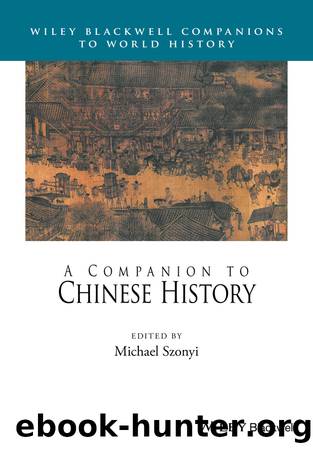A Companion to Chinese History by Szonyi Michael;

Author:Szonyi, Michael; [Szonyi, Michael]
Language: eng
Format: epub
Publisher: John Wiley & Sons, Incorporated
Published: 2017-04-01T00:00:00+00:00
Middle Era (317–1260)
The Middle Era (317–1260) saw profoundly changed attitudes and cultural practices resulting from huge shifts in population (from north to south, and from rural areas to urban centers), the transformative effects of the spread of Buddhism to all levels of society, the growth of imperial and private libraries, the compilation of massive anthologies, and the invention of printing (see the chapters by Holcombe and Tackett). Textual production in this era continued as a means to constitute political legitimacy, but was also used by an emerging class of “literati” (wenren) to take ownership of culture apart from centers of political power.
In 317 the ruling families of the W. Jin capital region of Luoyang fled rebellions and incursions by non‐Chinese tribes and established a new capital of the E. Jin (317–420) at Jiankang (modern Nanjing). While untold numbers of texts were lost in the turmoil north of the Yangzi river, the courts of the E. Jin and Southern Dynasties (420–589) managed to preserve, anthologize, and transmit texts from the Han dynasty and before, thus fashioning the canon of the Early Era of Chinese literature in the first centuries of the Middle Era.
Officials at the southern courts soon turned their compilation skills onto fresh subject matter found in their new locale. The court historian Gan Bao (286–ca. 336) collected “accounts of the strange” (zhiguai) describing supernatural occurrences involving ghosts, immortals, omens, and the like. His Records of Searching for Spirits (Soushen ji) expanded the scope of orthodox historical writing to heterodox topics, opening up possibilities for this form of narrative to be used as a means of social story‐making among the educated classes.
The royal courts continued to be the major sites of preservation, production, judgment, selection, and circulation of texts. Tao Qian (365–427), however, cultivated a pointedly uncourtly style in his writing, turning traditional genres obsessively inward to convince his readers (and perhaps himself) that he was successful in escaping officialdom by “Returning to Dwell in Gardens and Fields” (Guiyuantian ju), the title of his most famous series of poems. Xie Lingyun (385–433), who was forced into exile, sought solace in writing exquisitely crafted poetry that celebrated the tranquility of contemplating nature. Many of his poems are read as evidence of the importance that Buddhism played in his life, just as Tao Qian’s poems are sometimes read in a Daoist light.
A collection of short narratives called Stories of the Ages and Recent Anecdotes (Shishuo xinyu) was compiled by Liu Yiqing (403–44), a prince at the court of the Liu‐Song dynasty (420–79). Its 1,130 entries under 36 categories of human behavior depict educated men (and occasionally women and children) using wit and verbal facility to negotiate their relationships with one another, often displaying disdain for politics at court in favor of more refined activities such as music, poetry, wine, and abstruse conversations on literature and philosophy.
The literary salons of the southern courts were still the main sites of lively social exchange and competition through poetry and prose, spurring on sophisticated rhetorical techniques,
Download
This site does not store any files on its server. We only index and link to content provided by other sites. Please contact the content providers to delete copyright contents if any and email us, we'll remove relevant links or contents immediately.
| Africa | Americas |
| Arctic & Antarctica | Asia |
| Australia & Oceania | Europe |
| Middle East | Russia |
| United States | World |
| Ancient Civilizations | Military |
| Historical Study & Educational Resources |
The Songlines by Bruce Chatwin(2116)
The Fatal Shore by Robert Hughes(994)
Origins to Eureka by Thomas Keneally(716)
11 The Bear And The Dragon by Tom Clancy(613)
A Commonwealth of Thieves: The Improbable Birth of Australia by Thomas Keneally(600)
Eureka to the Diggers by Thomas Keneally(581)
Australia 1901 - 2001 by Andrew Tink(577)
A Commonwealth of Thieves by Thomas Keneally(563)
Shoot Straight, You Bastards! by Nick Bleszynski(535)
Dark Emu by Bruce Pascoe(530)
The Penguin History of New Zealand by Michael King(500)
Carnivorous Nights: On the Trail of the Tasmanian Tiger by Margaret Mittelbach; Michael Crewdson; Alexis Rockman(494)
James Cook by Peter Fitzsimons(489)
The Book Of Ian Watson by Ian Watson(484)
Venom by Brendan James Murray(484)
The Tall Man by Chloe Hooper(427)
Murder on Easey Street by Helen Thomas(397)
The Golden Country by Tim Watts(397)
Australian History for Dummies by Alex McDermott(367)
